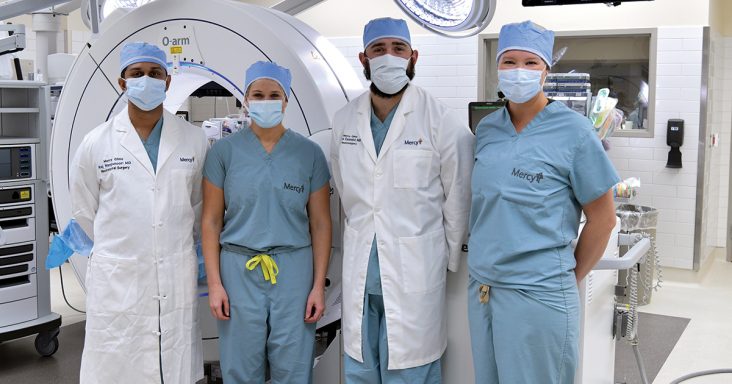Heartland Forward releases report on healthcare workforce
by July 4, 2022 2:08 pm 1,255 views

Pictured from left, Raj Nangunoori, neurosurgeon; nurse practitioner Kali Eddy; Alejandro Castellvi, neurosurgeon; and nurse practitioner Paula Stephens.
A new report released by Bentonville think tank Heartland Forward outlines strategies for building a robust healthcare workforce in the heartland.
According to the study, thousands of jobs remain unfilled across the country because the number of available positions outstrips the number of available workers.
The trend is most evident in the healthcare industry, where job openings outpaced qualified applicants even before the COVID-19 pandemic. As the demand for services increases, a functioning healthcare system requires a sufficient supply of workers.
“As the baby boom generation ages, it puts pressure on the system in two ways: there is more demand for its services and decreasing supply of healthcare professionals as older Americans retire,” Heartland Forward CEO Ross Devol said. “This is not a new problem, but in order for the heartland to realize its economic potential, it’s one we must approach with renewed vigor in light of the once-in-a-generation pandemic and its associated impact on employment. This report is practical, actionable and accessible.”
The report, “Keepers of a Healthy Heartland: Strategies for Building a Robust Health Care Workforce,” explores strategies for balancing supply and demand, especially among healthcare professions that need, at most, a bachelor’s degree. These 10 occupations are: medical assistants, phlebotomists, home health and personal care aides, licensed practical and licensed vocational nurses (LPNs), health information coders, registered nurses, surgical technologists, diagnostic medical sonographers, radiologic technologists and clinical lab technologists.
“Many healthcare occupations provide above-average wages and career growth potential, and many do not require a commitment to long-term training or multiple college degrees,” said Anu Chatterjee, Heartland Forward’s director of health research. “So this ‘ticket to the middle class’ is an important lens through which to view the opportunities and challenges in heartland communities.
“We hope that this report will enable those working in policy and workforce development to build partnerships to ensure there is an adequate pipeline of allied healthcare workers.”
Researchers analyzed five fast-growing regions in the heartland: Austin-Round Rock-Georgetown, Texas; Fayetteville-Springdale-Rogers, Ark.; Nashville-Davidson-Murfreesboro-Franklin, Tenn.; Durant, Okla.; and Oxford, Miss.
Across the 10 occupations, the report finds four challenges in those areas — general lack of awareness of these types of careers among potential workers, lack of educators who can teach and train the next generation of health care workers, insufficient pay and satisfaction across the occupations, and lack of coordination among the entities that supply workers.
The report proposes multiple policy strategies for local workforce development professionals and organizations hoping to recruit and retain workers in allied, supporting and non-physician healthcare occupations.
Multiple policy strategies are proposed for local workforce development professionals and organizations wishing to recruit and retain healthcare workers with allied, supporting, and non-physician occupations.
For a PDF of the 36-page report, click here.
